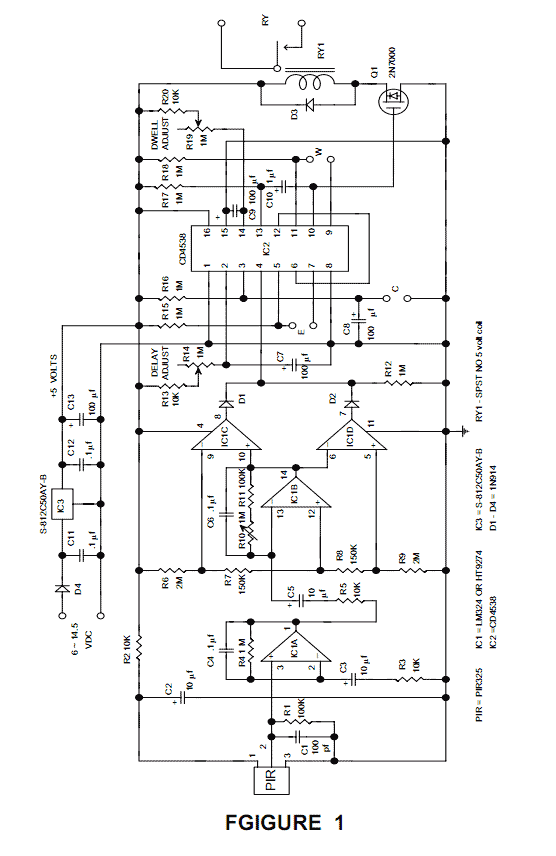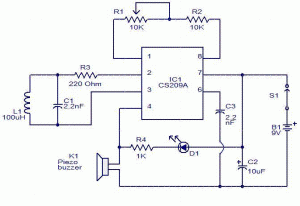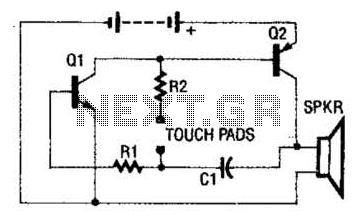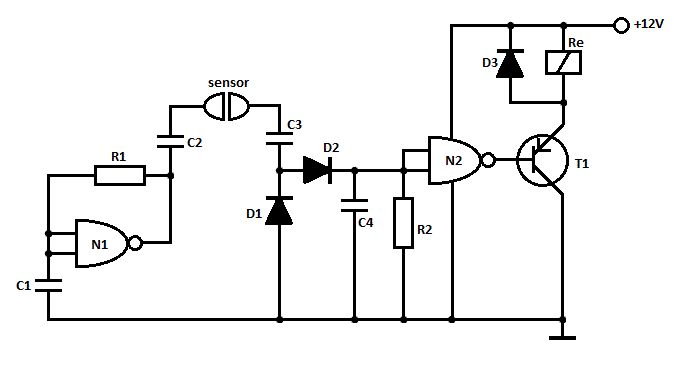
Infrared motion detector

The GLMDA is designed to detect the motion of a human or animal both in daylight and at night and to provide a normally open relay output that can be used to activate many types of loads. The GLMDA also has terminals for connecting an optional photocell to prevent activation of the load during daylight. More: The GLMDA is 1.7 X 2.4 inches with circuit components on one side and a pyroelectric infrared sensor on the other side. The module should be mounted with the 2.4 inch dimension vertical for maximum sensitivity to horizontal motion. Four holes on the corners accept # 4 mounting screws. A Fresnel lens or other focusing device can be placed in front of the sensor to increase sensing distance by focusing infrared radiation onto the sensor elements. Sensitivity The component side of the GLMDA has a sensitivity adjustment R10 that controls amplifier gain and therefore range (detection distance). Turning the adjustment clockwise increases sensitivity and gives a greater range. The pyroelectric infrared sensor in the GLMDA will detect a human or animal more easily at lower ambient temperatures when there is a greater difference between the human or animal body temperature and surrounding objects. Day / Night control An optional external resistive photo-conductive cell (not supplied) may be connected to the terminals marked C to de-activate the circuit during daylight so that a load will be activated only at night. This is useful if the GLMDA is used to turn a light ON. Delay between sensing A single shot circuit controls the amount of time that elapses between motion events that activate a load. This is useful for applications where continued motion might occur and rapid repeat activation of a load is not desired, for example when someone is standing outside a door in view of the sensor. Delay can be varied from 1 second to about 1.5 minutes by adjusting R14. The single shot is re-triggerable so that continued motion will extend the delay. Non re-triggering mode is selected by wiring a jumper across the terminals marked E. Time that load remains on Another single shot circuit controls the amount of time that a load remains turned ON after motion is detected. ON time can be varied from 1 second to about 1.5 minutes by adjusting R19. This is useful for applications such as keeping a light ON until a house is entered. The single shot is re-triggerable so that continued motion will extend the ON time. Non re-triggering mode is selected by wiring a jumper across the terminals marked W. Power A 6 to 14.5 volt battery will power the circuits. Power is connected to the GLMDA solder pads marked PWR, + and -. The module circuits draw less than 150 microamperes when no motion is detected and less than 50 milliamperes when motion is detected and the relay is energized. In average use with a short on time, the GLMDA will draw only 150 microamperes most of the time. A nine-volt alkaline battery should power the module for several months and possibly much longer. The power system is reverse polarity protected so that a reversed power source will not damage the circuits. A DC wall transformer may also power the GLMDA, however most wall transformers output much higher than their rated voltage when lightly loaded so the transformer output should be measured to be sure that the 14.5-volt maximum GLMDA power supply input is not exceeded. Capacitors in the amplifier and timing circuits require time to charge up to their normal operating voltages before the circuits will operate correctly. The circuits will not respond to motion until about one minute after power is applied.
The GLMDA motion detection module employs a pyroelectric infrared sensor, which is critical for detecting changes in infrared radiation emitted by moving objects, such as humans or animals. The device is compact, measuring 1.7 x 2.4 inches, and features a layout where the sensor is positioned on one side and circuit components on the other. For optimal operation, it is recommended to mount the module with the longer dimension (2.4 inches) oriented vertically, as this enhances sensitivity to horizontal motion.
The relay output is normally open, allowing it to activate various loads when motion is detected. An optional photocell can be integrated into the system to prevent activation during daylight hours, which is particularly useful for outdoor lighting applications. The sensitivity of the module can be adjusted via a potentiometer (R10), which modifies the amplifier gain, allowing for a customizable detection range. This adjustment is crucial, especially in environments with varying ambient temperatures, as the sensor's effectiveness increases when there is a significant temperature difference between the target and the surrounding environment.
The GLMDA includes features for controlling the timing of both the sensing and the relay activation. A single-shot circuit manages the delay between successive motion detections, adjustable from 1 second to approximately 1.5 minutes using resistor R14. This feature prevents the relay from activating too frequently in scenarios where motion may be continuous, such as a person lingering outside a doorway. Additionally, the relay activation duration after motion detection can be controlled with another single-shot circuit, adjustable via R19, ensuring that the load remains active for a specified period, enhancing user convenience.
Powering the GLMDA is achieved through a battery or a DC wall transformer, with a voltage range of 6 to 14.5 volts. The module is designed to draw minimal current (less than 150 microamperes) when idle, increasing to less than 50 milliamperes during active motion detection. This efficient power consumption allows for extended battery life, making it suitable for long-term applications. The circuitry includes reverse polarity protection to safeguard against incorrect power connections, and a delay period of about one minute is required after power-up for the capacitors to charge before the device becomes operational.
Overall, the GLMDA is a versatile motion detection module suitable for various applications, providing reliable performance with adjustable sensitivity and timing features.The GLMDA is designed to detect the motion of a human or animal both in daylight and at night and to provide a normally open relay output that can be used to activate many types of loads. The GLMDA also has terminals for connecting an optional photocell to prevent activation of the load during daylight.
The GLMDA is 1.7 X 2.4 inches with circuit components on one side and a pyroelectric infrared sensor on the other side. The module should be mounted with the 2.4 inch dimension vertical for maximum sensitivity to horizontal motion.
Four holes on the corners accept # 4 mounting screws. A Fresnel lens or other focusing device can be placed in front of the sensor to increase sensing distance by focusing infrared radiation onto the sensor elements. Sensitivity The component side of the GLMDA has a sensitivity adjustment R10 that controls amplifier gain and therefore range (detection distance).
Turning the adjustment clockwise increases sensitivity and gives a greater range. The pyroelectric infrared sensor in the GLMDA will detect a human or animal more easily at lower ambient temperatures when there is a greater difference between the human or animal body temperature and surrounding objects. Day / Night control An optional external resistive photo-conductive cell (not supplied) may be connected to the terminals marked C to de-activate the circuit during daylight so that a load will be activated only at night.
This is useful if the GLMDA is used to turn a light ON. Delay between sensing A single shot circuit controls the amount of time that elapses between motion events that activate a load. This is useful for applications where continued motion might occur and rapid repeat activation of a load is not desired, for example when someone is standing outside a door in view of the sensor.
Delay can be varied from 1 second to about 1.5 minutes by adjusting R14. The single shot is re-triggerable so that continued motion will extend the delay. Non re-triggering mode is selected by wiring a jumper across the terminals marked E. Time that load remains on Another single shot circuit controls the amount of time that a load remains turned ON after motion is detected. ON time can be varied from 1 second to about 1.5 minutes by adjusting R19. This is useful for applications such as keeping a light ON until a house is entered. The single shot is re-triggerable so that continued motion will extend the ON time. Non retriggering mode is selected by wiring a jumper across the terminals marked W. 4Power A 6 to 14.5 volt battery will power the circuits. Power is connected to the GLMDA solder pads marked PWR, + and . The module circuits draw less than 150 microamperes when no motion is detected and less than 50 milliamperes when motion is detected and the relay is energized.
In average use with a short on time, the GLMDA will draw only 150 microamperes most of the time. A nine volt alkaline battery should power the module for several months and possibly much longer. The power system is reverse polarity protected so that a reversed power source will not damage the circuits. A DC wall transformer may also power the GLMDA, however most wall transformers output much higher than their rated voltage when lightly loaded so the transformer output should be measured to be sure that the 14.5 volt maximum GLMDA power supply input is not exceeded.
Capacitors in the amplifier and timing circuits require time to charge up to their normal operating voltages before the circuits will operate correctly. The circuits will not respond to motion until about one minute after power is applied. 🔗 External reference
The GLMDA motion detection module employs a pyroelectric infrared sensor, which is critical for detecting changes in infrared radiation emitted by moving objects, such as humans or animals. The device is compact, measuring 1.7 x 2.4 inches, and features a layout where the sensor is positioned on one side and circuit components on the other. For optimal operation, it is recommended to mount the module with the longer dimension (2.4 inches) oriented vertically, as this enhances sensitivity to horizontal motion.
The relay output is normally open, allowing it to activate various loads when motion is detected. An optional photocell can be integrated into the system to prevent activation during daylight hours, which is particularly useful for outdoor lighting applications. The sensitivity of the module can be adjusted via a potentiometer (R10), which modifies the amplifier gain, allowing for a customizable detection range. This adjustment is crucial, especially in environments with varying ambient temperatures, as the sensor's effectiveness increases when there is a significant temperature difference between the target and the surrounding environment.
The GLMDA includes features for controlling the timing of both the sensing and the relay activation. A single-shot circuit manages the delay between successive motion detections, adjustable from 1 second to approximately 1.5 minutes using resistor R14. This feature prevents the relay from activating too frequently in scenarios where motion may be continuous, such as a person lingering outside a doorway. Additionally, the relay activation duration after motion detection can be controlled with another single-shot circuit, adjustable via R19, ensuring that the load remains active for a specified period, enhancing user convenience.
Powering the GLMDA is achieved through a battery or a DC wall transformer, with a voltage range of 6 to 14.5 volts. The module is designed to draw minimal current (less than 150 microamperes) when idle, increasing to less than 50 milliamperes during active motion detection. This efficient power consumption allows for extended battery life, making it suitable for long-term applications. The circuitry includes reverse polarity protection to safeguard against incorrect power connections, and a delay period of about one minute is required after power-up for the capacitors to charge before the device becomes operational.
Overall, the GLMDA is a versatile motion detection module suitable for various applications, providing reliable performance with adjustable sensitivity and timing features.The GLMDA is designed to detect the motion of a human or animal both in daylight and at night and to provide a normally open relay output that can be used to activate many types of loads. The GLMDA also has terminals for connecting an optional photocell to prevent activation of the load during daylight.
The GLMDA is 1.7 X 2.4 inches with circuit components on one side and a pyroelectric infrared sensor on the other side. The module should be mounted with the 2.4 inch dimension vertical for maximum sensitivity to horizontal motion.
Four holes on the corners accept # 4 mounting screws. A Fresnel lens or other focusing device can be placed in front of the sensor to increase sensing distance by focusing infrared radiation onto the sensor elements. Sensitivity The component side of the GLMDA has a sensitivity adjustment R10 that controls amplifier gain and therefore range (detection distance).
Turning the adjustment clockwise increases sensitivity and gives a greater range. The pyroelectric infrared sensor in the GLMDA will detect a human or animal more easily at lower ambient temperatures when there is a greater difference between the human or animal body temperature and surrounding objects. Day / Night control An optional external resistive photo-conductive cell (not supplied) may be connected to the terminals marked C to de-activate the circuit during daylight so that a load will be activated only at night.
This is useful if the GLMDA is used to turn a light ON. Delay between sensing A single shot circuit controls the amount of time that elapses between motion events that activate a load. This is useful for applications where continued motion might occur and rapid repeat activation of a load is not desired, for example when someone is standing outside a door in view of the sensor.
Delay can be varied from 1 second to about 1.5 minutes by adjusting R14. The single shot is re-triggerable so that continued motion will extend the delay. Non re-triggering mode is selected by wiring a jumper across the terminals marked E. Time that load remains on Another single shot circuit controls the amount of time that a load remains turned ON after motion is detected. ON time can be varied from 1 second to about 1.5 minutes by adjusting R19. This is useful for applications such as keeping a light ON until a house is entered. The single shot is re-triggerable so that continued motion will extend the ON time. Non retriggering mode is selected by wiring a jumper across the terminals marked W. 4Power A 6 to 14.5 volt battery will power the circuits. Power is connected to the GLMDA solder pads marked PWR, + and . The module circuits draw less than 150 microamperes when no motion is detected and less than 50 milliamperes when motion is detected and the relay is energized.
In average use with a short on time, the GLMDA will draw only 150 microamperes most of the time. A nine volt alkaline battery should power the module for several months and possibly much longer. The power system is reverse polarity protected so that a reversed power source will not damage the circuits. A DC wall transformer may also power the GLMDA, however most wall transformers output much higher than their rated voltage when lightly loaded so the transformer output should be measured to be sure that the 14.5 volt maximum GLMDA power supply input is not exceeded.
Capacitors in the amplifier and timing circuits require time to charge up to their normal operating voltages before the circuits will operate correctly. The circuits will not respond to motion until about one minute after power is applied. 🔗 External reference





